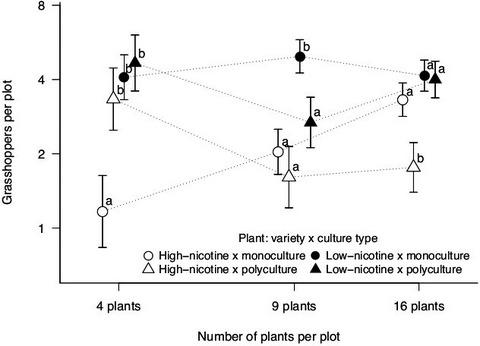当前位置:
X-MOL 学术
›
Funct. Ecol.
›
论文详情
Our official English website, www.x-mol.net, welcomes your
feedback! (Note: you will need to create a separate account there.)
Intraspecific neighborhood effect: Population‐level consequence of aggregation of highly‐defended plants
Functional Ecology ( IF 4.6 ) Pub Date : 2020-01-08 , DOI: 10.1111/1365-2435.13515 Momoka Tamura 1, 2 , Takayuki Ohgushi 3 , Takashi Y. Ida 1
Functional Ecology ( IF 4.6 ) Pub Date : 2020-01-08 , DOI: 10.1111/1365-2435.13515 Momoka Tamura 1, 2 , Takayuki Ohgushi 3 , Takashi Y. Ida 1
Affiliation

|
There is increasing evidence that herbivore–plant interactions on a focal plant species are influenced by interspecific neighbourhood effects via neighbouring plants (i.e. an associational effect). However, intraspecific neighborhood effects imposed by plant traits have been less appreciated. Specifically, the significance of intraspecific neighbourhood effects in population‐level consequences of plants has been totally overlooked. Using two varieties of Nicotiana tabacum (high‐ and low‐nicotine), we evaluated the neighbourhood effects based on patch‐level interactions in a split‐plot 3 × 3 factorial experiment that manipulated number of plants (4, 9 and 16 plants) and culture type (monoculture plots with high‐ and low‐nicotine plants, and polyculture plot) in an experimental garden. We found that herbivore visits on plants varied depending on the number of plants per patch and culture type. Presence of more high‐nicotine plants decreased herbivore visits in the four plant plots, and presence of high‐nicotine plants in the nine plant plots decreased herbivore visits on both high‐ and low‐nicotine plants. In contrast, in the 16 plant plots, herbivore visits on high‐nicotine plants in polyculture plots were lower than others, including those on high‐nicotine plants in monoculture plots. Our findings clearly demonstrated that the intraspecific neighbourhood effect could occur depending on the aggregation of highly defended plants (i.e. high density and/or plant‐spacing). This study suggests that multiple mechanisms for the neighbourhood effect simultaneously worked, depending on the patch size and composition of defensive traits of individual plants, and that intraspecific neighbourhood effects may influence population‐level consequences for plant–herbivore interaction. A free Plain Language Summary can be found within the Supporting Information of this article.
中文翻译:

种内邻里效应:高度防御植物聚集的种群水平后果
越来越多的证据表明,草食动物-植物对焦点植物物种的相互作用受到相邻植物的种间邻域效应(即关联效应)的影响。然而,植物性状强加的种内邻域效应鲜为人知。具体而言,种内邻域效应在植物种群水平后果中的重要性已被完全忽视。使用两种烟草品种(高尼古丁和低尼古丁),我们在操纵植物数量(4、9 和 16 株植物)的裂区 3 × 3 析因实验中评估了基于斑块级相互作用的邻域效应。实验花园中的栽培类型(具有高和低尼古丁植物的单一栽培地块和混养地块)。我们发现食草动物对植物的访问因每个补丁和培养类型的植物数量而异。更多高烟碱植物的存在减少了四个植物地块中的食草动物访问量,而九个植物地块中高烟碱植物的存在减少了高烟碱植物和低烟碱植物的食草动物访问量。相比之下,在 16 个植物地块中,混养地块中高烟碱植物的食草动物访问量低于其他地块,包括单养地块中高烟碱植物的访问量。我们的研究结果清楚地表明,种内邻域效应可能取决于高度防御植物的聚集(即高密度和/或植物间距)。这项研究表明,邻里效应的多种机制同时起作用,取决于斑块大小和单个植物防御性状的组成,并且种内邻域效应可能会影响植物 - 食草动物相互作用的种群水平结果。可以在本文的支持信息中找到免费的普通语言摘要。
更新日期:2020-01-08
中文翻译:

种内邻里效应:高度防御植物聚集的种群水平后果
越来越多的证据表明,草食动物-植物对焦点植物物种的相互作用受到相邻植物的种间邻域效应(即关联效应)的影响。然而,植物性状强加的种内邻域效应鲜为人知。具体而言,种内邻域效应在植物种群水平后果中的重要性已被完全忽视。使用两种烟草品种(高尼古丁和低尼古丁),我们在操纵植物数量(4、9 和 16 株植物)的裂区 3 × 3 析因实验中评估了基于斑块级相互作用的邻域效应。实验花园中的栽培类型(具有高和低尼古丁植物的单一栽培地块和混养地块)。我们发现食草动物对植物的访问因每个补丁和培养类型的植物数量而异。更多高烟碱植物的存在减少了四个植物地块中的食草动物访问量,而九个植物地块中高烟碱植物的存在减少了高烟碱植物和低烟碱植物的食草动物访问量。相比之下,在 16 个植物地块中,混养地块中高烟碱植物的食草动物访问量低于其他地块,包括单养地块中高烟碱植物的访问量。我们的研究结果清楚地表明,种内邻域效应可能取决于高度防御植物的聚集(即高密度和/或植物间距)。这项研究表明,邻里效应的多种机制同时起作用,取决于斑块大小和单个植物防御性状的组成,并且种内邻域效应可能会影响植物 - 食草动物相互作用的种群水平结果。可以在本文的支持信息中找到免费的普通语言摘要。











































 京公网安备 11010802027423号
京公网安备 11010802027423号